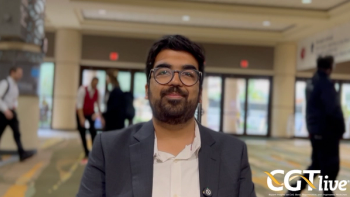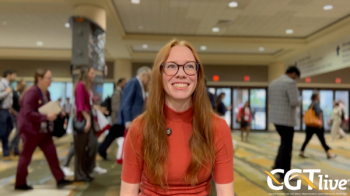
FDA Grants SQZ-PBMC-HPV Fast Track Designation for HPV+ Cancers
SQZ-PBMC-HPV receives FDA Fast Track Designation for patients with advanced or metastatic HPV16+ solid tumors, following promising early results.
The FDA has granted a Fast Track Designation to the therapeutic vaccine SQZ-PBMC-HPV as a potential treatment for patients with advanced or metastatic HPV16+ solid tumors, according to a statement from SQZ Biotechnologies, the company developing the cell therapy.1
Early findings for SQZ-PBMC-HPV from a first-in-human study were presented in December 2021 at the ESMO Immuno-Oncology Congress 2021.2 In this study, the cell therapy was considered safe and well tolerated at all doses administered, with mostly grade 1 and 2 non-specific adverse events (AEs) observed. There was 1 related serious AE experienced at the lowest dose (grade 2 cytokine release syndrome). In the highest dose cohort, there was a response observed in 1 of 5 patients treated with SQZ-PBMC-HPV (20%). This patient experienced a 49% reduction in tumor lesion size from baseline and showed robust signs of biomarker activity.
The therapy consists of autologous peripheral blood mononuclear cells (PBMCs) that are collected from the patient and combined with the target antigen, in this case HPV specific to the E6 and E7 oncoproteins. After combination the cells are squeezed through a microfluidic chip, which causes temporary openings in the PBMC membrane, a technology SQZ calls Cell Squeeze. This process allows for the target antigen to insert and diffuse into the cytosol of the cell. After exiting the chip, the membrane on the cell reseals. This process generates an enhanced antigen presenting cell (eAPC) that can be used for therapeutic purposes. In the first-in-human findings and preclinical reports, high CD8+ T cell responses were seen to the eAPC.
“We are thrilled to receive FDA Fast Track Designation for our SQZ Antigen Presenting Cells product candidate,” Armon Sharei, PhD, chief executive officer and founder at SQZ Biotechnologies, said in a statement. “This designation adds to our exciting clinical data presented at ESMO-IO last year where we first demonstrated the potential of our Cell Squeeze technology to drive clinical benefit while maintaining favorable tolerability. The FDA Fast Track program can potentially expedite future review processes and accelerate the registrational path for SQZ-PBMC-HPV.”
At the time of the presentation, the first-in-human phase 1 study had enrolled 18 patients with various types of HPV-driven, recurrent or metastatic, solid tumors (NCT04084951). All patients with HPV16-positive with the HLA-A*02 serotype. The dose escalation study examined various doses of the therapy given every 3 weeks, including a low dose (0.5 x 106 cells per kg) and 2 high dose cohorts (2.5 x 106/kg and 5.0 x 106/kg). Double priming of the cells took place for half of the 2.5 cohort (n = 4) and the full 5.0 cohort (n = 6).
The median time for manufacturing of the cells in the study was 17 hours. The time from patient leukapheresis to treatment was approximately 1 week. The median viability of the product was 91%, and in the highest dose cohort there was a median of 5 doses available for each patient.
The median age of patients enrolled in the study was 60 years, and the baseline ECOG performance status was 1 for most patients (67%). The primary sites of tumor were the head and neck (50%), anus (39%), and the cervix (11%). All patients had metastatic disease and all by 2 had received a prior immune checkpoint inhibitor, with the majority considered refractory this therapy (12/17; 71%).
Early signs of clinical efficacy were presented in the form of a patient case study of 1 individual with squamous cell carcinoma of the oropharynx who received 7 doses of SQZ-PBMC-HPV in the highest dose cohort. The patient had received 6 prior lines of therapy, including 2 with pembrolizumab (Keytruda). In this patient, a large influx of CD8 cells was seen following infusion of the cell therapy and a confirmed complete radiographic response was observed. There was a marked symptom improvement in dysphagia and neck swelling, including a substantially improved ability to swallow. AEs included grade 1 flushing and fatigue.
Across the full study, the most frequently observed AEs were fatigue (28%), flushing (17%), hypotension (17%), infusion related reaction (11%), nausea (11%), and pruritus (11%). These were all low-grade events. There was 1 grade 3 case of anemia in the 2.5 x 106/kg single-prime dose arm. No dose limiting toxicity was observed.
“The combined radiographic response and symptomatic improvement observed in this patient and the strong correlation with histological data demonstrated the investigational therapy’s intended cellular vaccine mechanism at work,” study first author and presenter Jong Chul Park, MD, Medical Oncologist and Investigator, Massachusetts General Hospital Cancer Center, said in a statement when the findings were presented. “This heavily treated patient with significant tumor burden in the neck had marked increases in CD8 T cell tumor infiltration which correlated with clinical improvement, including the ability to swallow more easily. SQZ-PBMC-HPV showed favorable safety data and was generally well tolerated in this patient and across all patients in the highest-dose cohort.”
In the responding patient, HLA-I expression, likely related to IFN-gamma secretion was seen. Additionally, the immunotype in this patient converted from a cold to a hot microenvironment. There were reductions seen in E6 and E7 and an increase observed in PD-L1 expression.
The next phase of the phase 1 trial is planning to examine SQZ-PBMC-HPV in combination with immune checkpoint inhibitors, with these early results suggesting synergy for this approach. The data safety monitoring board recommended the 5.0 x 106 cell dose for further study in the combination arm. The study is currently enrolling across the United States, Canada, and Germany. The combination phase is looking at the therapeutic vaccine with either atezolizumab (Tecentriq), ipilimumab (Yervoy), nivolumab (Opdivo), or a combination of ipilimumab and nivolumab. A monotherapy dose expansion arm is also available. The full study plans to enroll 200 participants (NCT04084951).
References:
SQZ Biotechnologies Receives FDA Fast Track Designation for its Lead Cell Therapy Candidate for the Treatment of HPV16+ Tumors. News release. SQZ Biotechnologies. April 28, 2022. Accessed April 28, 2022.
https://investors.sqzbiotech.com/news/news-details/2022/SQZ-Biotechnologies-Receives-FDA-Fast-Track-Designation-for-its-Lead-Cell-Therapy-Candidate-for-the-Treatment-of-HPV16-Tumors/default.aspx Park JC, Baranda J, Mita M, et al. Preliminary results of a first-in-human, dose-escalation study of a cell-based vaccine in HLA A*02+ patients with recurrent, locally advanced, or metastatic HPV16+ solid tumors. Presented at: ESMO Immuno-Oncology Congress 2021; Virtual, December 9, 2021.
Newsletter
Stay at the forefront of cutting-edge science with CGT—your direct line to expert insights, breakthrough data, and real-time coverage of the latest advancements in cell and gene therapy.

















































